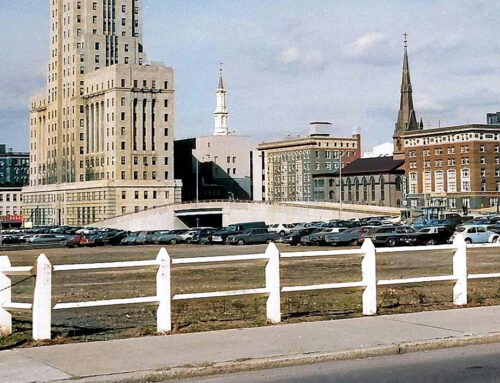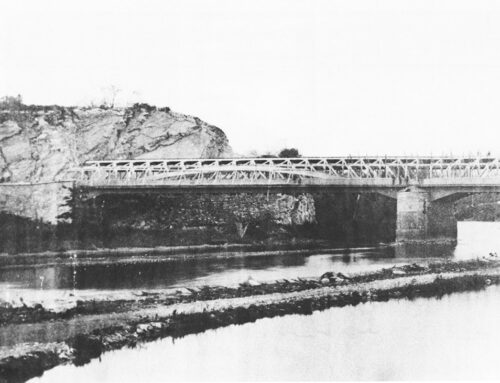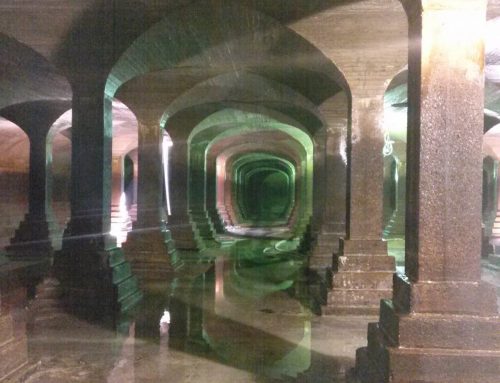The county commissioners were authorized by an Act passed April 23, 1829, to erect a bridge over the Schuylkill River at Gerber’s ferry, on the road from Reading to Lancaster. It was finished in 1831. The bridge was a one lane, two span wooden structure with a length of 352 feet. It was known as the “Lancaster Bridge.” The Lancaster Covered Bridge was one of twelve covered toll bridges in Berks County. Tolls were charged at the bridge until 1883.
In 1839, a part of the bridge was swept away by a flood. The damage was so severe that the bridge had to be rebuilt. Two years later the flood of 1841 completely swept away the bridge and the bridge again had to be rebuilt.
Below: The three span 1841 Lancaster Covered Bridge with the Union Canal in the foreground and the City of Reading in the background.

The County, after losing the same bridge twice within two years, decided to rebuild the Lancaster Bridge several feet downstream on new piers that were 4 ½ feet higher than the original piers to avoid damage from future floods. In doing this, the length of the bridge was increased to 580 feet, consisting of 3 spans of 193 feet 4 inches each.
The Flood of 1850 completely washed away the Lancaster Bridge once again. A portion of the Penn Street Bridge lodged for a moment on the City Island, but was immediately carried downward, and dashed broadside against the Lancaster Bridge, sweeping a large portion of it from its abutments. The remainder of the Lancaster Bridge was carried away shortly afterwards.
The bridge was rebuilt in 1851. This time the bridge was built 6 feet higher to protect it from future floods.
In 1869, the eastern one-third of the bridge was swept away by another flood and was again rebuilt.
In 1876 (July 9th) the bridge was destroyed by fire – the act of young incendiaries. Two boys, Ellis Smith, age 9, and Harry Smith, age 7, admitted to setting fire the bridge. In 1877, the two boys charged with setting fire to the bridge were acquitted by a jury.
Shortly before, there were loud complaints about the insecurity and darkness and unpleasant condition on account of dust of the wooden bridge.
On Jan. 1, 1877, a new three span iron bridge replaced the old covered bridge, which had burnt down. It was the first large iron bridge-structure erected in the county. The bridge name was changed to the Bingaman Street Bridge in honor of Peter Bingaman who owned the land in that vicinity. In 1883, the iron bridge became toll free.
Below: A pedestrian walkway parallels the iron bridge , circa 1913.

As early as March of 1915 the county commissioners recommended and approved a new concrete bridge at the foot of Bingaman Street. On April 12, 1915 the court approved the building of the new bridge. On January 7, 1920 the Commissioners of Berks County entered into a contract with John F. Whittaker and D.L. Diehl for the erection and construction of the bridge.
Below: Construction of Bingaman Street Bridge, Reading, 1920.

In 1921 the concrete viaduct was erected at a cost of nearly $800,000.00. The bridge was finished later in 1921 and had a length of 1,587 feet, had 13 spans, and was 60 feet in width. The width included a 39-foot roadway and two sidewalks of 10 feet 6 inches on each side. This new concrete bridge was dedicated on Saturday, December 3, 1921. At the time it was constructed, the bridge was one of the largest bridges built in PA.
In 1970 the bridge was rehabilitated and in 2017 the bridge was rehabilitated again.
Below: Trolley Car No. 808 pases over the new Bingaman Street Bridge (1931).

Below: Bingaman Street Bridge from the Air Circa 1950.






